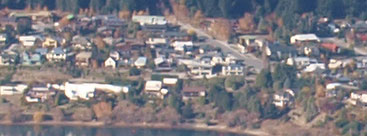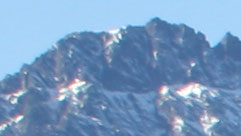Olympus E-420
-
-
Written by Gordon Laing
Olympus E-420 vs Canon EOS 400D / XTi vs EOS 450D / XSi
Olympus E-420: JPEG versus RAW
We photographed the scene here in RAW + Large Fine JPEG mode and have presented crops below from each file for comparison. The RAW file was converted using Olympus Master 2.05 using its default settings, saved as a 16-bit TIFF, then opened in Photoshop. This was then reduced to 8 bits and processed the same way as the original JPEG for presentation here. There’s virtually no difference here between the processed RAW file and in-camera JPEG, although to be fair, the Master software was using the camera defaults. Of course the flexibility of shooting in RAW is greater latitude for adjustments, and the Master software lets you change plenty of settings including the colour style and noise filter – this can be a great way of experimenting with different processing settings before applying your favourites in-camera. Now to see how the camera performed under studio conditions, check out our Olympus E-420 resolution results. |
Olympus E-420 JPEG with Zuiko Digital 25mm |
Olympus E-420 RAW with Zuiko Digital 25mm | |
 |  | |
f8, 100 ISO |
f8, 100 ISO |
Olympus E-420 results continued…
 |
outdoor scene |
 |
To compare real-life performance we shot the same scene with the Olympus E-420, Canon EOS 400D / XTi and the EOS 450D / XSi within a few moments of each other using their Aperture Priority modes, best quality JPEG and lowest ISO settings. The lenses on each camera were set to f8 and adjusted to deliver the same vertical field of view – see note below.
The E-420 was fitted with the Zuiko Digital 25mm f2.8 and both Canon’s with their respective EF-S 18-55mm kit lenses.
The image left was taken with the Olympus E-420 and 25mm lens at f8 and a sensitivity of 100 ISO; the original JPEG measured 4.74MB. The crops are taken from the upper left, centre, lower right and lower left portions of the originals and presented here at 100%.
Note: The Olympus E-420, like all Four Thirds DSLRs, captures images with a 4:3 aspect ratio that’s narrower than the 3:2 aspect ratio of most DSLRs including both Canon models here. In this test we adjusted the lenses on the Canons to deliver the same vertical field of view as the E-420 with its 25mm lens, so we’re not using the full width of the Canon images. As such, the 400D / XTi and 450D / XSi are only using 8.9 and 10.8 of their total Megapixels here respectively.
Comparing a fixed focal length lens with two kit zooms may seem like the E-420 has an unfair advantage, but these are the common lens bundles for each body, and it also provides an opportunity to show the differences between the optics.
Indeed the major differences between the samples below are down to their respective optics as oppose to sensor resolution or image processing. Where the lenses are performing well, all three cameras deliver roughly the same degree of real-life detail – although again note both Canons have vertical strips on either side of their images that we’re not considering here.
Both our Canon kit zooms become soft in the lower right corner though, which doesn’t affect the Olympus 25mm pancake lens – you can really see the differences in the third row of crops. In fact the 25mm remains pretty sharp right into the edges and corners which is more than can be said for most kit zooms. Compared to a top-end zoom like the Zuiko Digital 12-60mm, there’s evidence of slightly more coloured fringing in the extremes, but overall, it’s an excellent result for the pancake lens. As you’ll see here and in our sample images pages, it’s also more flexible than you might think as a walkaround lens – don’t assume you absolutely need a zoom.
Now either scroll down to check out the E-420’s RAW performance, or head straight over to our studio tests in the E-420 resolution page.
Olympus E-420 with Zuiko Digital 25mm |
Canon EOS 400D / XTi with Canon EF-S 18-55mm |
Canon EOS 450D / XSi with Canon EF-S 18-55mm IS | ||
 |
 |
 | ||
f8, 100 ISO |
f8, 100 ISO |
f8, 100 ISO | ||
 |
 |
 | ||
f8, 100 ISO |
f8, 100 ISO |
f8, 100 ISO | ||
 |
 |
 | ||
f8, 100 ISO |
f8, 100 ISO |
f8, 100 ISO | ||
 |
 |
 | ||
f8, 100 ISO |
f8, 100 ISO |
f8, 100 ISO |




